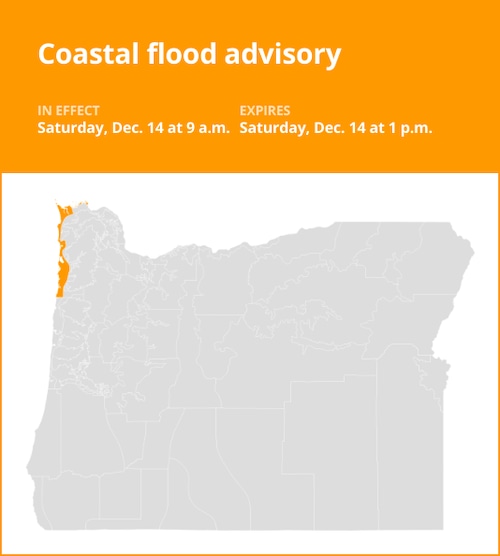At 10:49 a.m. on Friday, the National Weather Service issued a revised coastal flood advisory for Clatsop County Coast and Tillamook County Coast, which is in effect for Saturday between 9 a.m. and 1 p.m.
“Tidal overflow flooding expected,” the weather agency adds. “On Saturday, the tides are predicted to peak at approximately 11 a.m. It is anticipated that the tidal gauges at Toke Point, Tongue Point, and Garibaldi will peak at 12.2, 11.3, and 10.7 feet, respectively.
“Minor flooding, up to one foot above ground level, during high tides is expected in the low-lying areas near bays, sloughs, and the lower reaches of the coastal rivers,” according to the weather service. “Tidal overflow flooding is anticipated when there is a coastal flood advisory in effect. Residents living along the coast in the region under warning should be on the lookout for rising water and take the necessary precautions to save lives and property.
Breaking down weather alerts: advisories, watches, and warnings
-
Flash flood warning: Take action!
When a flash flood is approaching or already happening, a warning is sent. Get to high ground right away if you’re in a flood-prone location. A flash flood is a quick, intense flood that can form in a matter of minutes to hours. Even in places that don’t get rain right away, flash floods can happen.
-
Flood warning: Take action!
When flooding is expected or is happening, a flood warning is issued.
-
Flood advisory: Be aware:
When flooding is not predicted to be severe enough to warrant a warning, a flood advisory is issued. But if care is not taken, it could result in circumstances that endanger life and/or property and cause a great deal of discomfort.
-
Flood watch: Be prepared:
When the weather is conducive to flooding, a flood watch is issued. Flooding is not guaranteed, but it is a possibility.
When floods strike: Guidelines from the weather service for your protection
Floods can be a serious hazard, particularly if you live in a flood-prone location or camp in a low-lying area. The weather service provides crucial flood protection instructions to protect you:
Go to a higher location:
Moving to higher ground should be your first course of action if you’re camping in a low-lying location or in an area that is prone to flooding.
Respect evacuation directives:
Respond quickly to any evacuation orders issued by local authorities. Secure your home by locking it before you leave.
Cut off appliances and utilities:
Disconnect your appliances and utilities if you have the time. By doing this, the possibility of electrical risks during floods is decreased.
Steer clear of waterlogged regions and basements:
Avoid basements or rooms with electrical outlets or cords submerged in water. This lessens the chance of electrical mishaps.
Quickly leave for your safety:
Evacuate right away if you see sparks or hear popping, crackling, buzzing, or snapping sounds. Steer clear of any water that might be electrically charged.
Avoid the floodwaters:
Even if floodwaters seem shallow, you should never try to go over them. You can be swept off your feet with power by just 6 inches of swift-moving water.
If you’re stuck, look for high ground:
If you find yourself caught by flowing water, get to the highest position you can and call 911 to get help.
floods is more likely during periods of high rainfall, particularly in areas that are low-lying and prone to floods. No matter how shallow the water looks, you should never drive through it. The weather service claims that most cars can be washed away by as little as 12 inches of swiftly moving water. Put your safety first by being aware and ready.
United Robots offers a service called Advance Local Weather Alerts that gathers the most recent information from the National Weather Service using machine learning.
Note: Every piece of content is rigorously reviewed by our team of experienced writers and editors to ensure its accuracy. Our writers use credible sources and adhere to strict fact-checking protocols to verify all claims and data before publication. If an error is identified, we promptly correct it and strive for transparency in all updates, feel free to reach out to us via email. We appreciate your trust and support!







